Impeccable (T-AGOS-23)
2000–
The second U.S. Navy ship named for the general word classification. The first Impeccable, a minesweeper (AM-320), was reclassified to a fleet minesweeper (MSF-320) on 7 February 1955, and served (with brief interruptions) from 1944–1972.
(T-AGOS-23: displacement 5,380; length 281'; beam 96'; draft 26'; speed 10 knots; complement 41; armament none; class Impeccable)
The second Impeccable (T-AGOS-23) was laid down on 15 March 1992 at Tampa, Fla., by American Shipbuilding Co.; launched on 25 April 1998; towed -- after American Shipbuilding declared bankruptcy -- to Gulfport, Miss., where Halter Marine, Inc., completed her; co-sponsored by Mrs. Margareta Augustine, wife of Chief Executive Officer of Lockheed Martin Corp., Norman Augustine, and Mrs. Leah Gansler, wife of Under Secretary of Defense Jacques S. Gansler, the Chairman of the Nuclear Weapons Council; and placed in service with the Military Sealift Command (MSC) on 13 October 2000.
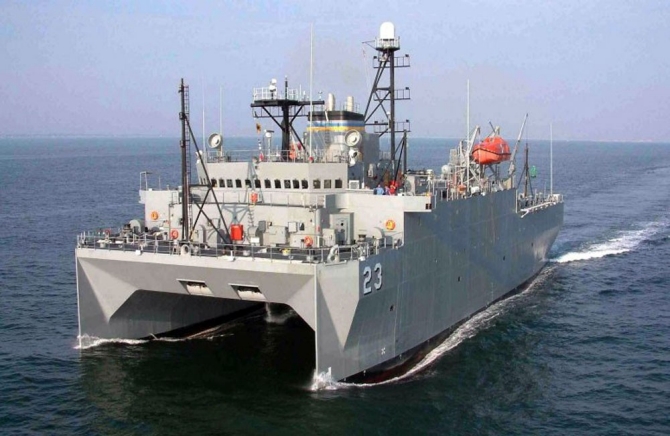
Impeccable -- an MSC-manned ocean surveillance ship that uses primarily the AN/UQQ-2 Surveillance Towed Array Sensor System (SURTASS) to gather underwater acoustical data -- operates as part of the Command’s Special Mission Ships Program, supporting antisubmarine warfare operations of the Atlantic and Pacific Fleets. In addition, Impeccable carries electronic equipment to process and transmit that data via satellites to shore stations for evaluation. She is built on a small-waterplane, twin-hull design for greater stability at slow speeds in high latitudes under adverse weather conditions, and usually deploys to the Western Pacific Ocean.
Chinese and U.S. ships dangerously confronted each other in 2009. A Chinese patrol vessel shined a high-intensity spotlight on MSC-manned ocean surveillance ship Victorious (T-AGOS-19) as she sailed in the Yellow Sea about 125 miles from the Chinese coast, on 4 March. The following day, Chinese maritime aircraft repeatedly flew over the ship at low altitude. A Chinese frigate meanwhile crossed Impeccable’s bow at a range of about 100 yards. Maritime aircraft “buzzed” the ship after that incident. On 7 March another Chinese vessel challenged Impeccable over bridge-to-bridge radio, calling her operations illegal and directing the American ship to leave the area or “suffer the consequences,” officials said. “We view these as unprofessional maneuvers by the Chinese vessels and violations under international law,” Pentagon spokesman Bryan Whitman explained, “to operate with due regard for the rights and safety of other lawful users of the ocean.”
On 8 March, five Chinese vessels -- a naval intelligence collection ship, Bureau of Maritime Fisheries and State Oceanographic Administration patrol vessels, and two small Chinese-flagged trawlers -- surrounded Impeccable as she steamed about 70 nautical miles off Hainan Island in international waters in the South China Sea. Two closed to within 50 feet. Impeccable’s mariners used fire hoses to spray one of the vessels as a protective measure, but the Chinese crewmen stripped down to their underwear and continued closing to within 25 feet. The Chinese dropped pieces of wood in the water directly in Impeccable’s course, and two of the ships hove to directly ahead of the American ship, compelling her to stop. The Chinese used poles while attempting to snag Impeccable’s towed acoustic array sonars, but her master informed the Chinese via bridge-to-bridge radio circuits that she was coming about and requested a safe course to navigate. Despite the harassment, Impeccable eventually broke away and cleared the area.
These are dangerous close maneuvers that these vessels engaged in,” Whitman elaborated. “We expect Chinese ships to act responsibly,” a Defense Department official added, “and refrain from provocative activities that could lead to miscalculation or a collision at sea, endangering vessels and the lives of U.S. and Chinese mariners.” U.S. Embassy officials lodged a protest against these actions with the Foreign Ministry in China, and Defense Department officials protested with the Chinese embassy in Japan.
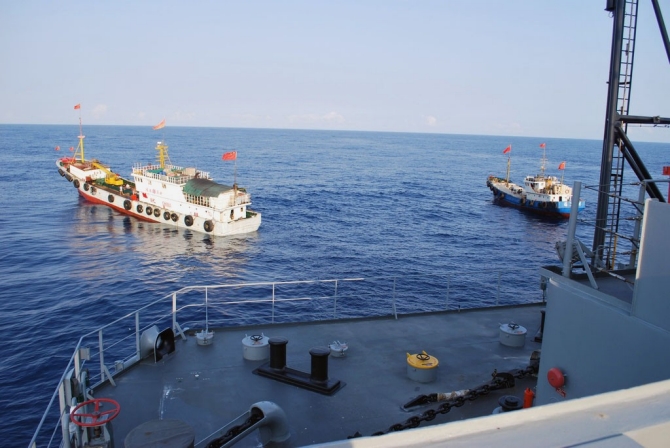
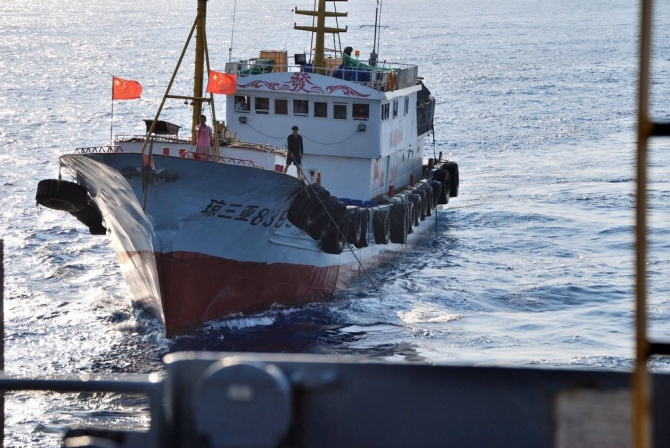
On 19 July 2015, Impeccable en route to Subic Bay, rescued 11 fishermen in the South China Sea while she steamed en route to Subic Bay, Philippines. A look out spotted people clinging to a ship all but awash, and also noted debris in the water. Robert Wiechert, Impeccable’s master, immediately directed his crew to deploy their rigid hull inflatable boat (RHIB). “This was a team effort,” Wiechert recalled, “with civilian mariners, SECDET [security detachment], MILDET [military detachment] and Lockheed Martin working together to achieve an efficient rescue of all 11 fishermen.”
“They [Impeccable mariners] initially spotted only eight people on the partially submerged vessel,” Lt. Cory Hilgart, the theater anti-submarine watch officer at Commander, Task Force 74, explained. “They then realized that it was actually 11 and made the call to commence the rescue effort.” The RHIB crew made three trips to the distressed vessel and rescued all 11 souls. “One of the crew members spoke English,” Hilgart added. “He told the Impeccable crew that they were fishermen from the Subic Bay region. He confirmed that there were only 11 on board.”
Impeccable’s medical team examined the fishermen for possible injuries or exposure to the elements, and once they determined that none of the rescued people had sustained any serious injuries or illnesses, her crewmembers gave them food and water. Shortly after Impeccable reached Subic Bay the following day, the Americans turned over all 11 mariners to the Philippine Coast Guard.
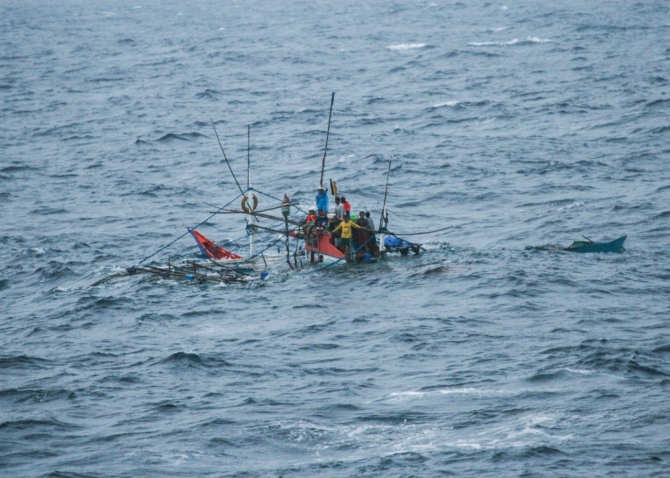
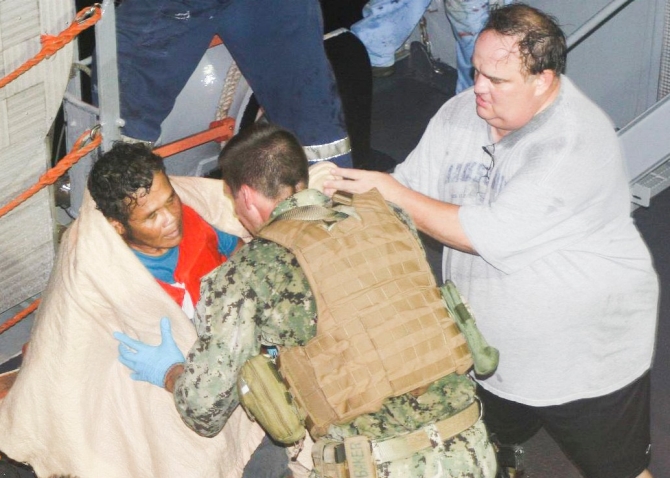
Detailed history pending.
Mark L. Evans
9 November 2015


